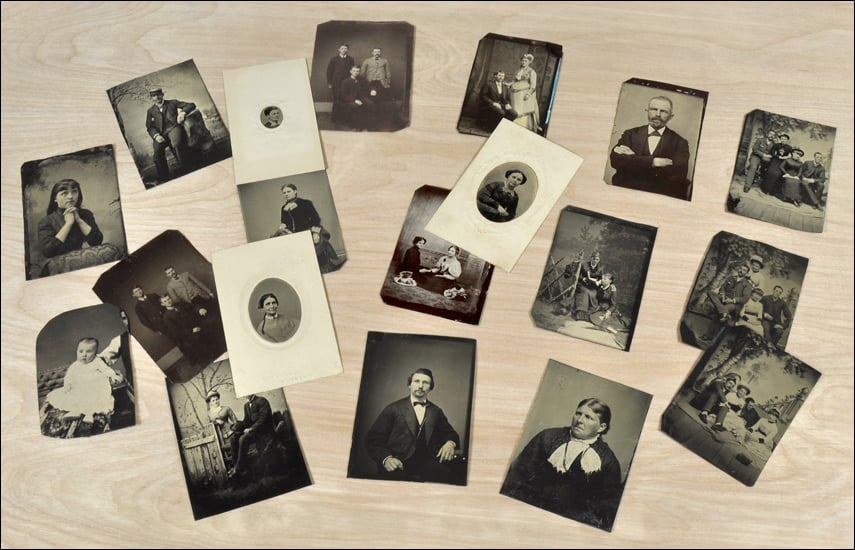Have you ever wondered about those curious photographs in your family archive that appear to be printed on a thin sheet of metal?
Well, these are tintypes, a popular 19th-century photographic process—actually on a piece of lacquered iron, not tin—used extensively for studio portraiture, as well as for occasional exterior photographs.


While seemingly standard poses were common, tintypes also often captured the personality of the sitter in unique ways . . .
. . . and were sometimes posed or photographed with elaborate studio backdrops and props that made these unique images come alive.
Let’s look at how to archivally preserve tintypes in your collection!
Scanning Tintypes
Full tintype plates measured 6.5 x 8.5 inches and were most often cut up prior to sensitizing with photographic chemicals to yield smaller-sized plates: the common sixth plate (below left) was created from a full plate that had been cut into six smaller sheets, and the larger quarter plate (below right) was created from a full plate that had been cut into four smaller sheets, and so on.
Each of these sizes can be readily accommodated in a number of museum-quality archival materials, but we recommend scanning them first.

Scanning these wonderful family treasures will allow you to print and work with the scan while safely storing the original.
While the most common tintypes are small, the process often yielded a tremendous amount of detail. Scan your tintypes at a higher resolution in order to get a larger image and see far more detail. You can share these files with relatives and print scans for your photo album.

If there is information on the back of your tintypes, consider scanning that too, as temporarily adjusting contrast and color settings might make otherwise unreadable information much clearer.
Safe Archival Storage for Tintypes
One of the best and most convenient archival enclosures for protecting your one-of-a-kind tintypes is the HD (High Density) Poly Envelopes, which are available in sizes that perfectly fit a variety of tintype formats.

These inexpensive museum-quality enclosures will help prevent dust, finger oils, or moisture from coming into contact with your images during handling and storage. They’re also translucent, which helps you easily find a particular image you’re looking for.

Storing your tintypes in archival enclosures is important as these thin metal plates sometimes have bent corners or edges that can scratch adjacent images if they’re not otherwise separated and protected.
If storing a number of family or collectible tintypes, you can organize groups of them in Open End Envelopes.
An entire family’s worth of 19th-century tintypes and other small photographs can be organized and stored in one convenient place, with identification information written on individual envelopes and index dividers.

Another way to store your one-of-a-kind tintypes is to place them in Crystal Clear Bags with a sheet of Acid-Free Card Stock added for additional rigidity and support. You can also write important identification information on these sheets of card stock with an archivally-safe pencil or marker.
As mentioned, tintypes come in a variety of sizes and formats, and are occasionally found in elaborate 19th-century cases. In the photo below, the large quarter plate tintype is lying on top of an archivally-safe Polyethylene Bag, which fits it perfectly. These bags come in a variety of sizes, and are the ideal solution for protecting cased images.
Creating an Archivally-Safe Album
You can also integrate your irreplaceable family or collectible tintypes into your photo albums by placing them in Print Pages. Note that Acid-Free Card Stock has been added to each print page pocket for added stability and support.
These print pages can then be placed in an archivally-safe Binders, which are handmade at our facility in Rochester, NY.
Using Acid-Free Card Stock behind your images will also allow you to write identification information with archivally-safe pencils or markers.
Protecting Antique Albums
There were a number of different 19th-century album designs that accommodated tintypes. If you have one of these, consider scanning the images within and then archivally storing the actual album.
Place album in an archival Polyethylene Bag and then into an acid-free Metal Edge Box. We offer Book Storage Kits but if they don’t suit your needs there are many different sizes and designs of archival boxes available.
Archivally Display Your Favorite Tintypes

Some tintypes just need to be archivally matted and framed to be enjoyed every day!
If you’re thinking of doing this, consider using an 8-ply mat rather than a standard 4-ply mat, as tintypes have a certain depth—especially if they have subtle bends in them—and you don’t want the image surface to come into contact with the frame’s glass or glazing.
In the photo above the large quarter plate tintype is being “floated” in the center of the mat in order to show the entire plate. This is easy to do yourself with with Mounting Corners.
An Additional Gallery of Wonderful Tintypes!



In closing, we hope you’ll contact us here at Archival Methods if you have any additional questions on how to best preserve and share your family or collectible tintypes. These unique images deserve only the finest in archival care!
Lastly, for more information on tintypes from the Image Permanence Institute’s Graphics Atlas, please click here.












